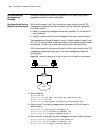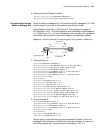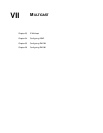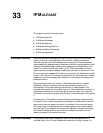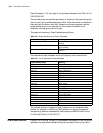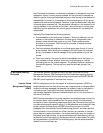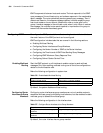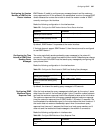502 CHAPTER 33: IP MULTICAST
Multicast Routing
Protocol
The group address in the multicast protocol is a virtual address. Therefore, unlike
unicast, data packets cannot be routed directly from the data source to the
specific destination address. The multicast application program sends the data
packet to a group of receivers instead of a single receiver .
Multicast routing establishes a cyclic data transmission path from one data source
end to multiple receiving ends. The task of the multicast routing protocol is to
establish a distribution tree structure. The multicast routers can adopt many
methods to establish a data transmission path distribution tree. Protocol
Independent Multicast (PIM) is the protocol that allows multicast routers to
identify other multicast routers that will receive the packets. Depending on actual
network conditions, the multicast routing protocol can be divided into two kinds -
dense mode and sparse mode.
Protocol Independent
Multicast--Dense Mode
(PIM-DM))
The dense mode of the multicast routing protocol is suitable for small networks
with abundant bandwidth. Suppose that each subnet in the network has at least a
pair of receiving sites interested in multicast. Therefore, multicast data packet are
distributed to all the sites in the network. Together with this process there is
consumption of the related resources (bandwidth and the CPU of the router). To
decrease the consumption of these precious network resources, the dense mode
of the multicast routing protocol “prunes” the branches that do not have
multicast data forwarding, and retains only the branches that contain the receiving
sites.
To enable the receiving sites with the multicast forwarding demand in the pruned
branches to receive multicast data flow, the pruned branches can return to
forwarding state periodically. To reduce the time delay for the pruned branch to
recover to the forwarding state, the dense mode of the multicast routing protocol
adopts a grafting mechanism to actively add to the multicast distribution tree. This
cyclic diffusion and pruning phenomenon is the feature of the dense mode of the
multicast routing protocol. Generally, the data packet forwarding path in the
dense mode is an “active tree” with the source being its root and the group
members being its leaves.
The typical routing protocol in the dense mode includes Protocol-Independent
Multicast-Dense Mode (PIM-DM) and Distance Vector Multicast Routing Protocol
(DVMRP).
Protocol Independent
Multicast-Sparse Mode
(PIM-SM)
Dense mode uses the flood-prune technology, which is not applicable for a WAN.
In a WAN, multicast receivers are sparse and the sparse mode is used. In sparse
mode, all hosts do not need to receive multicast packets unless there is an explicit
request for the packets by default. A multicast router must send a join message to
the rendezvous point (RP), which is created in the network as the virtual place for
data exchange. The RP corresponds to the group that receives the multicast data
traffic from the specified group. The join message passes routers and finally
reaches the root, the RP. The path that the join message used becomes a branch of
the shared tree. In PIM sparse mode, multicast packets are sent to the RP first and
then are forwarded along the shared tree rooted at the RP and with members as
the branches. To prevent the branches of the shared tree from being deleted
because they are not updated, PIM sparse mode sends join messages to branches
periodically to maintain the multicast distribution tree.



